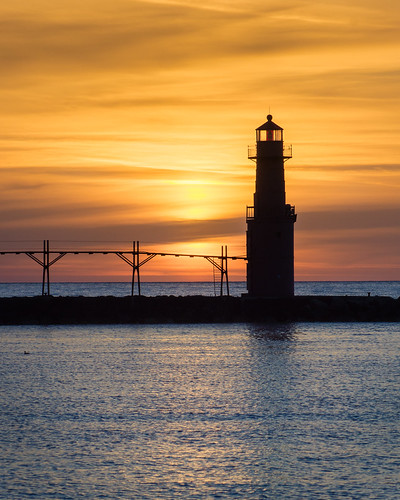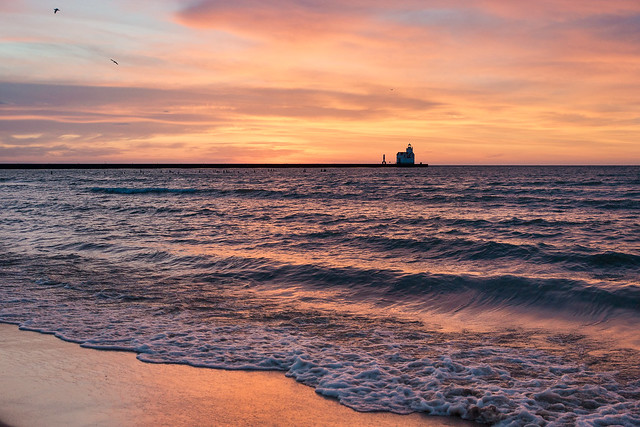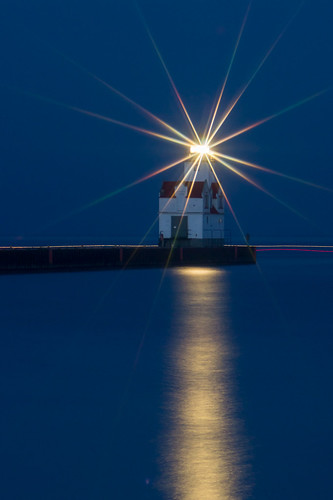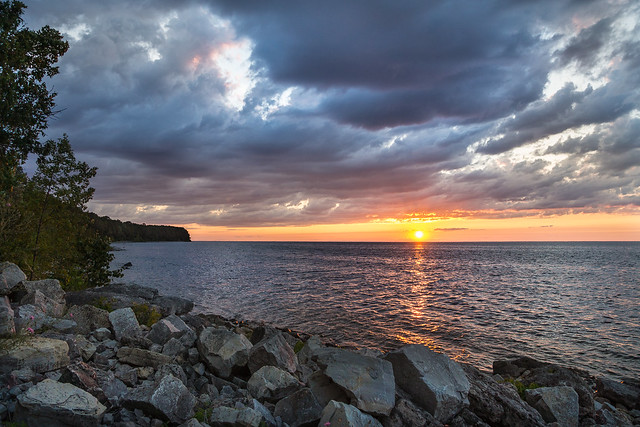Reflection
Fire Painters In the Sky
 This image is a combination of stunning, natural beauty and a generous helping of digital magic. Let me share some of the details.
This image is a combination of stunning, natural beauty and a generous helping of digital magic. Let me share some of the details.
This is one of my earliest photos taken with my first decent digital camera. The camera a Kodak EasyShare DX7590 that I purchased to document my first trip to Liberia, Africa in 1995 . The DX7590 was a minor step up from a typical point-and-shoot camera with a whopping 5-megapixels. (Pretty impressive, in those days, for a small, consumer grade camera. My current camera provides 24-megapixels.)
This photo was taken in march of 2007. At home in the early evening, I saw the wonderful colors in the sky out my living room window. Of course, I grabbed my camera and dashed out the door.
I crossed the road in front of my house to be able to frame up the sky without any interference from the power lines and poles between me and the beauty. I included the dormant tree to add contrast and interest to the scene. I snapped several frames of the incredible sky with the trees and field before me.
If you haven’t guessed by now, the water you see in the foreground wasn’t part of the original scene. I added the water, digitally, after the fact. The lovely, rippling reflection of the water in this image replaced a barren farm field, mostly covered with melting snow. You can see a couple of the original images I took – with out the water effect – in this earlier post: Fire In the Sky
The farm field was dark and dreary, compared to the sky, so I thought it needed an upgrade. I had been trying out a trial version of software developed to add a water effect and thought the reflective quality of water might add more interest and color to the bottom of the image. In fact, I extended the bottom area of the photo, to fit more ripples in the view.
You can view a larger version of this photo by clicking on it.
Winter Blues
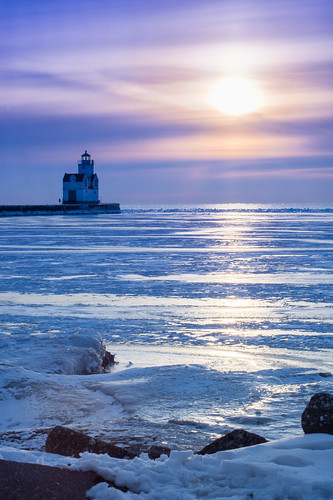 As you know, winter has been reluctant to release its grip on Northeast Wisconsin. This is a scene that reminds me of the battle between warmth and cold. The cold seems to be winning, preventing the sun from having its full effect. We’re all believing for the sun to triumph, the ice and snow to melt and warmer summer breezes to induce the gentle sound of waves on Lake Michigan’s shore.
As you know, winter has been reluctant to release its grip on Northeast Wisconsin. This is a scene that reminds me of the battle between warmth and cold. The cold seems to be winning, preventing the sun from having its full effect. We’re all believing for the sun to triumph, the ice and snow to melt and warmer summer breezes to induce the gentle sound of waves on Lake Michigan’s shore.
This is a view of the Kewaunee, Wisconsin lighthouse shortly after sunrise…as seen from the snow and ice-covered beach. To view a larger, more detailed version, click on the photo.
Wide Scene Format

The sky offered larger-than-life beauty but to take advantage of the opportunity I would have to take several photos and join them together to capture this wide, panoramic view.
This is a sunrise over Lake Michigan, behind the Kewaunee, WI pier and lighthouse. I like the way this photo gives the viewer a good idea of just how long this pier extends into the lake.
Because I combined four separate images (each 24mb) to create this image, it resulted in a huge file. The file was large enough to choke my computer to a near standstill. It took me many hours, twiddling my thumbs while it processed, to arrive at the final product.
Unfortunately, the narrow format of my website doesn’t do justice to the panoramic view. To view a larger version – one that will stretch the full width of your monitor – click on the image.
Amiable Awakening
Nothing is more enjoyable than watching the sky transition through a warm array of colors as the sun rises above Lake Michigan, behind the Algoma, WI harbor and lighthouse. It doesn’t happen every morning. In fact, it doesn’t happen more than it does. But when it does, it’s well worth the effort to have a front row seat.
Popular Night Spot
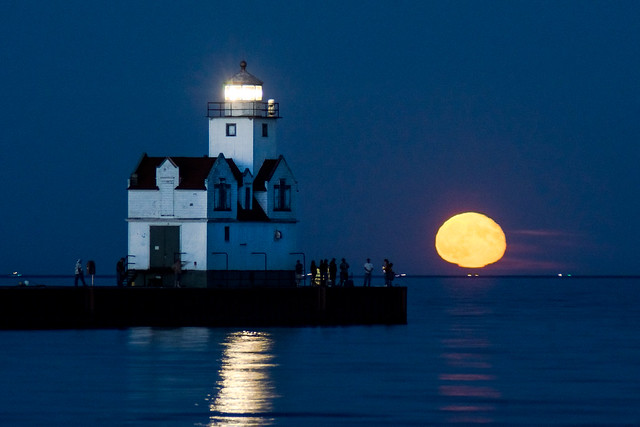
A number of people waited near the lighthouse, at the end of the long, Kewaunee, WI pier, to watch the full moon rise above Lake Michigan.
This was an August full moon. The small lights you see on the horizon are fishing boats out on the lake. I took this photo from the beach with a large zoom lens.
To view a larger version of this image, simply click on the photo.
Beyond the Veil
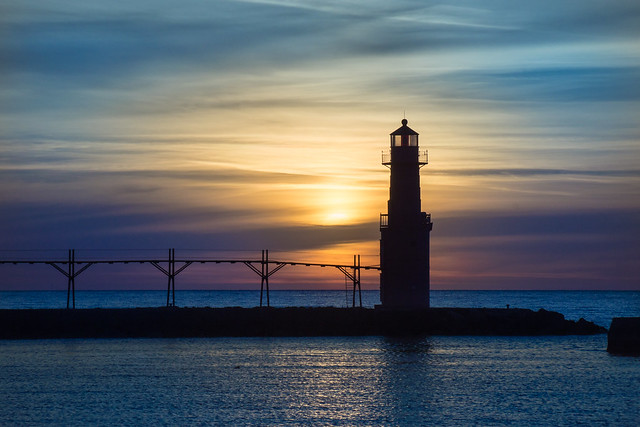
The sun had risen well above the Lake Michigan horizon, but the clouds, acting as a veil, kept its full glory from illuminating the Algoma, Wisconsin lighthouse and pier.
I really like the subtlety of texture and light behind the thin clouds and the blue hues of early morning.
To view a larger version of this image, click on the photo.
Hope On the Horizon
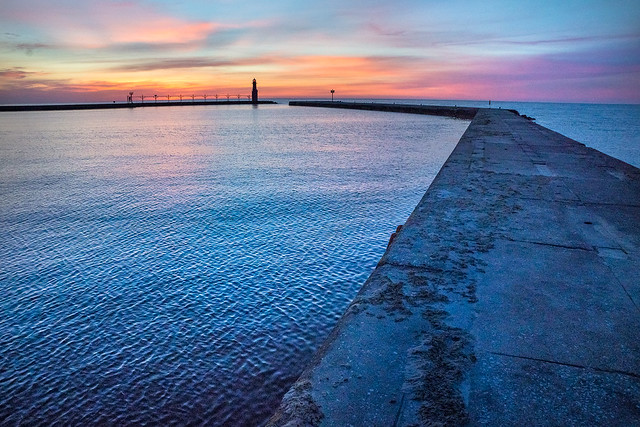
The best colors of the morning sky happen a little before sunrise. This is the view, from the south pier, of the Algoma, Wisconsin harbor and lighthouse. In a few minutes, the sun will rise over Lake Michigan.
If you look at the larger version of this image, you’ll be able to see the glow of the familiar red light from the lighthouse. To view a larger version, click on the photo.
Shoreline Stroll
Star Bright
I went out to photograph a full moon…but ended up focusing on a star.
This is a long exposure, early evening view of the Kewaunee, Wisconsin Lighthouse. This is not the shot I was going for, but that’s the way it works sometimes.
I’d been watching the lunar calendar and decided the best evening to capture the full moon rising over Lake Michigan would be Friday. When it was time to head for the beach, I noticed a band of clouds in the sky but thought they might be high enough to not block the horizon. Turns out, there was enough “atmosphere” between me and the moon, I didn’t see it until much later in the night.
Since I was at the beach and had everything set up, I thought I’d fiddle around getting a night shot of the lighthouse. While fiddling, I thought the star filter I have might add a nice effect to the bright lighthouse light. The star filter is threaded so you can screw it on to the end of the lens. It creates an X pattern over any bright light source in the photo’s frame. I’ve often wanted more lines then the four it’s designed to create, but it is what it is. …or is it?
I took the star filter off the lens and decided to try and just hold it very still, by hand, in front of the lens. That worked better than expected. Next I took a shot and held the filter still it for a few seconds and rotated it a few degrees and, again, held it still. That gave me more points to the star…and it looked pretty good. I experimented a bit more to end up with this version.
This is a 20-second exposure. (20-sec, f/11, ISO 200) I was holding the filter in front of the lens – as close as I could without actually touching the lens. When I tripped the shutter (with a remote), I would count to five, rotate the filter, count to five, rotate the filter, count to five and quickly remove the filter for the remainder of the exposure. As you can see, that gave me three separate sets of star points.
Let me point out a few other interesting effects from the long exposure time. The lake wasn’t as smooth as it seems in this image. The long exposure has a tends to smooth out any motion. You might also notice a small, dark, oblong spot near the corner of the pier, just to the right of the lighthouse. That is actually a man who was fishing off the pier. He moved enough over the 20-seconds that all you see is a blur. And finally, there are a couple of thin lines of light that run horizontal through the frame…about level with the deck of the pier. Those are lights from a boat that was leaving the harbor, traveling left to right over the span of the 20-second exposure.
To view a larger version of this image, click on the image.



















































